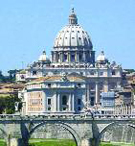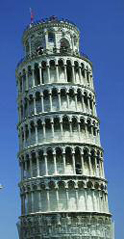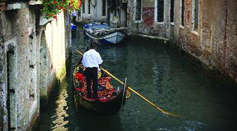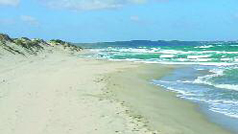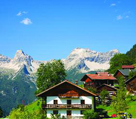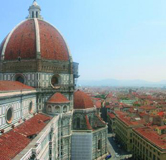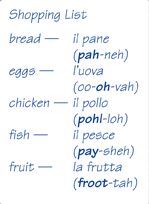Looking At ITALY
Where in the World Is Italy?, What Is the Geography of Italy?
Where in the World Is Italy?
Benvenuti in Italia! Welcome to Italy!
Italy is on the continent of Europe. It is located in southern Europe. Italy is easy to see on the map. Just look for the boot sticking out into the Mediterranean Sea. The island of Sicily is at the toe of the boot. The island of Sardinia is west of Italy. Sicily and Sardinia are also part of Italy.
Italy is 116,300 square miles (301,217 sq km). It's a bit larger than the state of Arizona. It is more than 600 miles (966 km) long. That makes it about a hundred miles longer than Florida. Like Florida, Italy is also a peninsula. It is surrounded by water on three sides. In the south of Italy, the winters are mild. Summers are hot and dry. The north has snowy winters.
Italy is one of the most visited countries in Europe. In 2004, Italy had over 37 million visitors. Tourists love the mild climate. They also enjoy the beautiful mountains and beaches. People also love to visit its ancient buildings and its museums filled with art treasures.
Every country has its own history. The people have their own customs and traditions. They make each country unique.
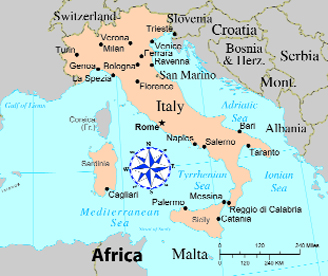 Political Map of Italy
Political Map of Italy
What makes Italy Italian? The country has an exciting mix of ancient and modern art and design. Italy is filled with history. There are wonderful ruins of Greek and Roman statues. It has many old temples and buildings. Today, Italy is known for its high standard of living. It is one of the most developed countries in the world. Italians are also famous for beautifully designed clothes and products.
What do you think of when you hear the name Italy? Here are some pictures that show a few ideas about Italy. How many do you know?
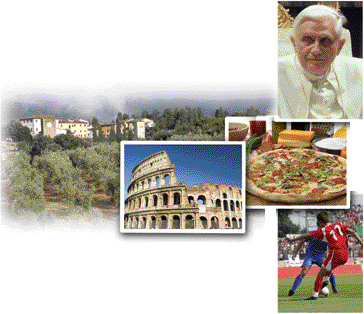
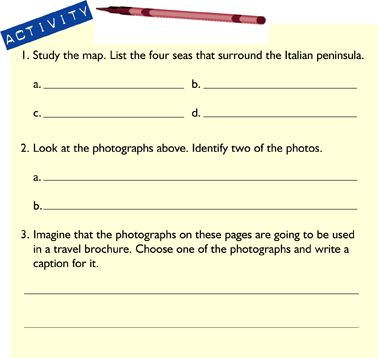
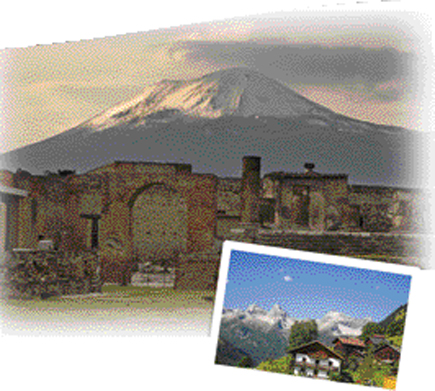 Pompeii archaeological site with Mount Vesuvius in the background
Pompeii archaeological site with Mount Vesuvius in the background
The Alps mountain range seen from Tirol, Italy
What Is the Geography of Italy?
Italy is a land of contrasts. The north has high snow-covered mountains. The south has hot, dry plains. As you can see, Italy juts out in the Mediterranean Sea. Steep mountains or hills cover over 75 percent of Italy. Cities could not develop in the high, snowcapped Alps in the far north. The Apennines (a-puh-nynz) run along the whole peninsula like a backbone. The steep mountain ridges and windswept highlands do not have fertile soil. The mountains divide the country in half.
Italy also has Europe's only active volcanoes. The earth's crust is divided into large pieces called tectonic plates. These plates fit together like the pieces of a puzzle. As these plates slowly move toward each other, they rub together and create heat. This heat makes the rock melt. The liquid rock moves up and erupts through holes in the earth's surface. These holes are volcanoes. Mount Etna and Mount Vesuvius are two of these volcanoes.
In the past twenty-five years, Italy has had several major eruptions. Mount Etna is located on the Italian island of Sicily. It is one of the world's most active volcanoes. When Etna erupts, it explodes out lava, ash, and gases. It has killed people and animals living on the island. It has also destroyed farmland and towns.
Italy's mountains make farming difficult. However, just south of the Alps is a very fertile area called the Northern Plain. This land around the Po River is good for crops. The area is famous for its rice production.
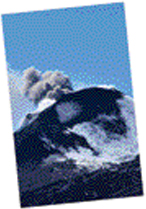 Mount Etna
Mount Etna
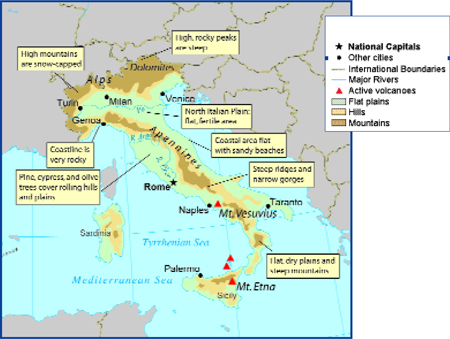 Physical Map of Italy
Physical Map of Italy
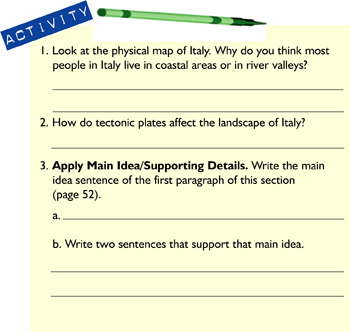
What Is the Climate Like in Italy?
Think about the climate in your state. Do you have warm or cold winters? Are your summers hot and humid or hot and dry? Italy has a mix of climates. The climates fall into three geographical regions. In the northern region, winters are cold and wet. The summers are hot and dry. This is called a continental climate.
The next region is the Po Valley area. It lies in the North Italian Plain. Here the summers are dry. But the winters are freezing and damp. The third region is in the south. It has long, hot summers and mild winters. This is called a Mediterranean climate. In spring and summer, hot, dry winds blow across Italy from North Africa. These winds are called siroccos (shuh-rah-kohz). Of course, cool weather along Italy's backbone, the Apennines, can bring snow during the winter.
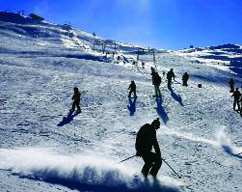 Skiers enjoy the slopes in the Alps
Skiers enjoy the slopes in the Alps
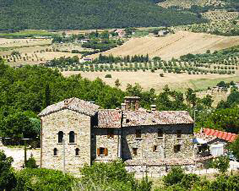 Farm and house in Southern Italy
Farm and house in Southern Italy
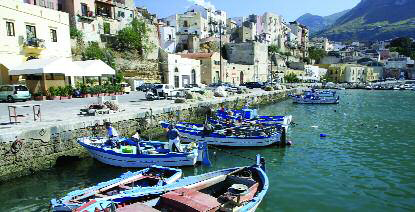 Castellammare del Golfo – a fishing village in Sicily
Castellammare del Golfo – a fishing village in Sicily
Look back at the map on page 53. Find the cities of Milan and Venice in the north. Then find Rome and Naples on the west coast of Italy. Now locate Palermo in Sicily. Notice where they are in relationship to one another. Now read the table below.
| City | Average Monthly Highest Temperatures | Average Monthly Rainfall (inches) | Average Daily Hours of Sunshine | |||
|---|---|---|---|---|---|---|
| Jan | July | Jan | July | Jan | July | |
| Milan | 41°F | 82°F | .8 | 3.9 | 2 | 8 |
| Venice | 45°F | 82°F | 3.5 | 4.3 | 2 | 9 |
| Rome | 54°F | 84°F | 3.4 | .8 | 5 | 10 |
| Naples | 55°F | 86°F | 3.3 | .5 | 4 | 11 |
| Palermo | 59°F | 84°F | 2.3 | .3 | 4 | 11 |
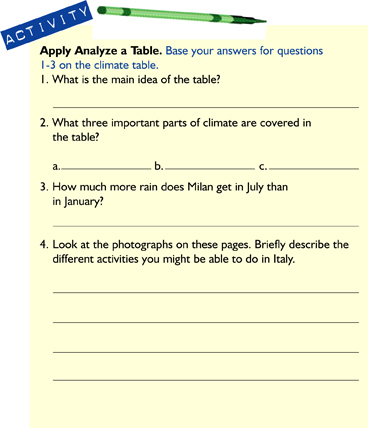
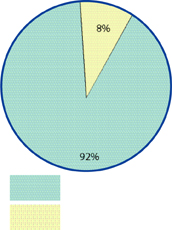
How Do Italians Use the Land?
How many factory-made products do you use every day? You woke up this morning. Did you use a factory-made alarm clock? You turned on the faucet to get some water. The faucet was made in a factory. Your jeans and shirt are made in a factory. Think about what natural resources were used to make these products.
People use land and resources to make products. A raw material is a resource or material that is still in its natural state. It has not been turned into a product yet. In manufacturing, raw materials are turned into finished products. For example, a farmer takes his wheat grain to a mill. Wheat grain is a raw material. The mill grinds the grain into wheat flour. The raw material has been manufactured into a product that we use.
Italy does not have many natural resources. It must import about 80 percent of its energy. Imports are goods brought in from other regions or countries. It also imports raw materials to make manufactured goods. Only about 20 percent of Italy is forest. So it must import most of its wood. Italians have a fishing industry. They catch anchovies, sardines, and octopus. But the seas around Italy are no longer the rich fishing grounds they were in the past. Pollution and over fishing have caused these problems. Italy exports very little fish.
Southern Italy and the Northern Plain are the most important farming areas. Farmers grow grapes, fruits, olives, wheat, rice, corn, and vegetables. Vineyards in the hills are famous for their wines. But as more people move to the cities, fewer people farm.
Besides wine, Italy is the sixth largest producer of cheese and wool. Italians raise beef, pork, and lamb. But they must import most of their meat to meet the needs of the population.
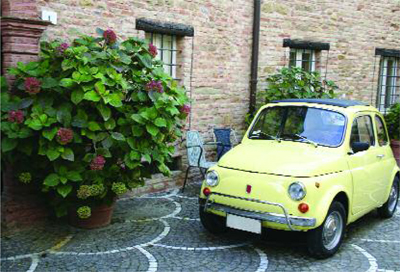 Italian-made Fiat in a village in Tuscany
Italian-made Fiat in a village in Tuscany
Italy's Industry. Italy does not have many natural resources. It imports them so that it can manufacture finished products. When countries work together, they are interdependent. That means countries rely on one another for resources, goods, or services. Italy uses imported resources to produce cars, shoes, machinery, cloth, and leather goods. To name just a few.
Find the cities of Milan, Turin, and Genoa. These cities form Italy's industrial triangle. Milan is the commercial and business center. Turin is the industrial center. And Genoa is a major port. Goods are exported to other countries from Genoa. Exports are goods sent to other regions or countries for trade.
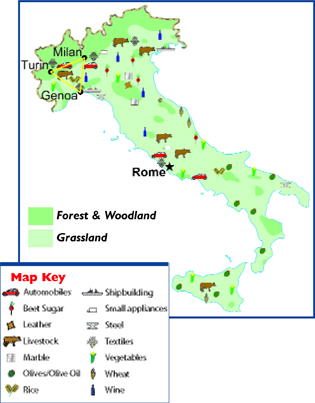 Land Use in Italy
Land Use in Italy
Because Italy has few resources, this area was slow to develop. There was not enough energy. Today, energy for this region comes mostly from hydroelectric power stations (using the flow of water to produce electricity), natural gas, and nuclear power plants. This region has helped to make Italy one of the richest nations in the world.
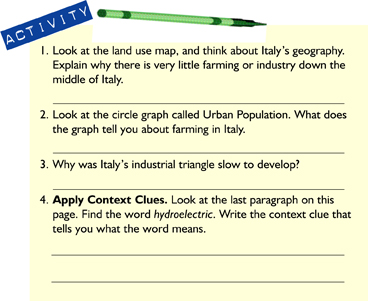
How Has History Shaped the People of Italy?
The Greeks and Etruscans 750 B.C. Several different groups lived in Italy. There were native peoples. Then the Greeks settled in Sicily and along the southern coast. They planted grapes and olives. (Today, Italy is one of the leading producers of the finest olive oil in the world.) Native tribes traded with the Greeks. They brought direct rule by the people, or democracy.
About 750 B.C., the Etruscans settled central Italy. No one is sure where the Etruscans came from. They were farmers, miners, and engineers. They built sewers and drained the swampy land that would later become Rome. They traded with the Greeks and the native people.
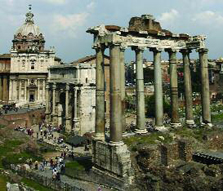 The Roman Forum was built in the 6th century on marshland that was drained.
The Roman Forum was built in the 6th century on marshland that was drained.
The Roman Empire 509 B.C. Many ancient civilizations have made major contributions to the modern-day world. The Roman Empire began about 509 B.C. and lasted to about A.D. 476, almost one thousand years. It was one of the most advanced cultures of its time.
The Romans have had long-lasting effects on the societies of the entire world. Signs of their skill and creativity are still found in many modern countries. There are remains of roads, walls, baths, churches, outdoor theaters, and aqueducts (channels built to carry water over long distances). These show the brilliance of Roman engineers and architects. Many modern buildings have been built using Roman style and methods. Perhaps the most important and far-reaching contributions were their government institutions (the legal codes and systems) that have influenced western political life up to the present.
Europe would be a different place without the Romans. They founded cities across the continent that still stand today. For example, the great city of London, the capital of the United Kingdom, was founded by the Romans. They named it Londinium.
The Romans also gave us our alphabet. It is what most of the western world uses today. We have added a few letters to it, like W and X, but it is still much the same alphabet used by the Romans.
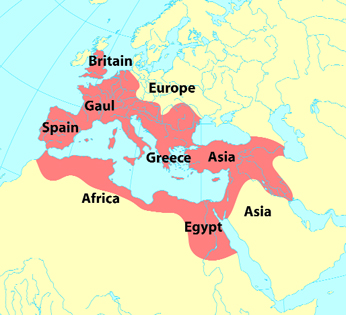 The Roman Empire, A.D. 117
The Roman Empire, A.D. 117
The Fall of the Roman Empire. For two hundred years, Rome ruled over a vast territory, an area that is ruled by another government. Rome's rule stretched from Britain in northern Europe and west to North Africa. So why did Rome fall? To support large armies, Romans were heavily taxed. Large landowners used slaves for labor. Small farmers could not compete. Many large estates were poorly run, so there was less food. People without jobs could not pay large taxes. Diseases spread through the area, killing about a third of the people. By A.D. 476, the Roman Empire was destroyed by invaders.
For the next thousand years, Italy once again became a mix of city-states. A city-state is a central city and its surrounding countryside. The area has one form of government, follows the same laws, and shares the same language and religious beliefs. Rome was the most powerful city-state and home to the Catholic Church. This period is known as the Dark Ages.
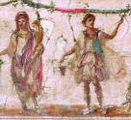 The Lararium of the Termopolium in Pompeil is one of the best preserved examples from the Roman world.
The Lararium of the Termopolium in Pompeil is one of the best preserved examples from the Roman world.
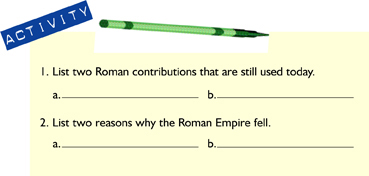
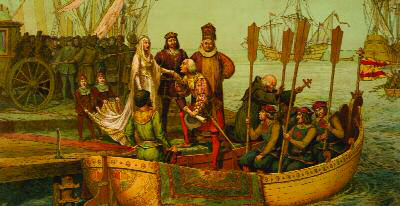 Columbus bids farewell to the queen of Spain, August 3, 1492.
Columbus bids farewell to the queen of Spain, August 3, 1492.
The Golden Age of Exploration and Culture. Finally, wealth returned in the fourteenth century. City-states, such as Florence, Milan, Pisa, Genoa, and Venice became centers of trade.
This was the beginning of the Renaissance, which means “rebirth.” This period was the beginning of a new age. The wealth from trade made Italy into the center of this change.
Wealthy merchants funded writers, architects, artists, and scientists. This was the time of Leonardo Da Vinci, Michelangelo, Dante, Machiavelli, and Galileo. Famous art from this era includes Da Vinci's The Last Supper, painted in 1497, and Michelangelo's sculpture David. Scholars became interested in the world and the people around them. This cultural era lasted from the 14th to the 116th century. The interest in science, art, and education spread to other cities in Europe. Explorers, such as Marco Polo and later, Christopher Columbus, helped spread Italian and European culture to the rest of the world.
Italy Comes Together. When Mediterranean trade routes changed in the sixteenth century, the Italian city-states became weak and were conquered by Spain, France, and Austria. Until the 1800s, Italy remained a mix of areas controlled by other European countries. Napoleon brought all the city-states together. People began to see the importance of working together as one country.
But the wars continued. Some people wanted the Pope to rule. Others wanted families from their area to rule the country. Finally, in 1870, the fighting was over. The country was united.
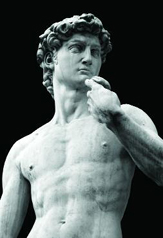 Michelangelo's sculpture David.
Michelangelo's sculpture David.
Modern Italy and the World Wars. Italy had a king, a constitution, and an elected parliament. A parliament is a group of people who make the laws for a country. In 1921, a politician named Benito Mussolini founded the Fascist Party. Fascism (fash-ihz-uhm) is a belief that supports a strong central government. It is controlled by the military and led by a powerful dictator. A dictator is a ruler who has complete control.
In the 1930s, Mussolini invaded Albania and Ethiopia. Before long, however, Italy began to lose control of North Africa and the Mediterranean. In 1943 during World War II, Italy was freed from his control. Mussolini lost power.
After World War II, Italy became a democratic republic. But the wealthy North and the poorer South continued to argue. Italy has had many coalition governments. This is when two or more political parties work together to run the country.
Today, Italy is a democratic republic. Power rests in an elected parliament and prime minister. Italy is one of the richest nations in Europe and a member of the European Union.
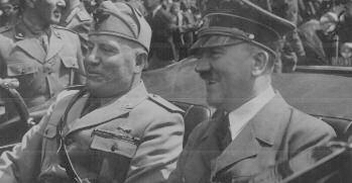 Mussolini with Adolf Hitler in Munich, 1940
Mussolini with Adolf Hitler in Munich, 1940
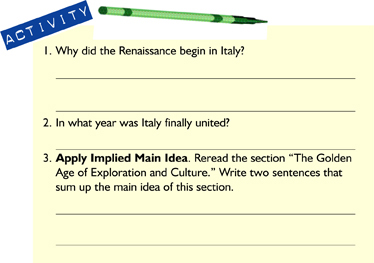
Tourism is a big part of Italy's economy. Why do millions of people visit the country every year? Think about what you have learned so far. Italy has beautiful landscapes. There are deep forests and snow-capped mountains in the north. People go to see volcanoes. There are miles of sunny, sandy beaches.
Italy also has a long and interesting history. You can visit ancient Roman buildings. There are beautiful villas, or homes. Finally, there is the weather. Almost all of Italy has hot summers and long hours of sunshine. Here are some exciting places to visit.
Read the lists of some attractions Italy offers. How many interest you?
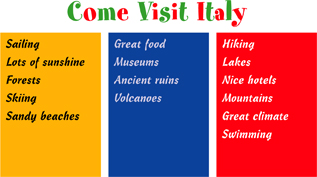
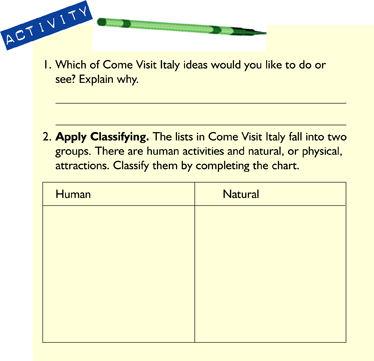
Where Do People in Italy Live?
Life in the North. Over 58 million people live in Italy. The most populated places are in the North and near the coast. There is a good reason for this. The North Italian Plain has flat, fertile soil. It is good for farming. This region is the richest part of the country. Only 4 in 100 workers are farmers, but farming is still a major land use. This area is also home to the industrial triangle. The largest industrial centers of Milan and Turin are here. The seaport of Genoa is nearby.
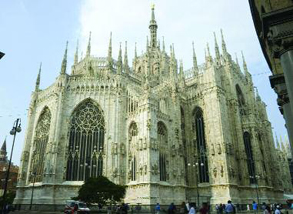 The Duomo (Cathedral) in Milan
The Duomo (Cathedral) in Milan
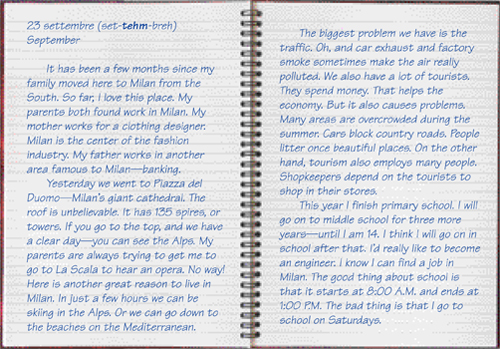 Tomaso lives just outside of Milan. Here is one of his journal entries.
Tomaso lives just outside of Milan. Here is one of his journal entries.
Life in the South. The capital city of Rome is the imaginary dividing point for the industrial North and the more relaxed South. Southern Italy makes up the boot of the peninsula, together with the islands of Sardinia and Sicily. The South is not as developed as the North.
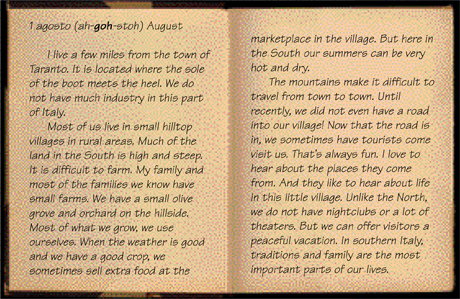 Maria lives in the South. Read one of Maria's journal entries.
Maria lives in the South. Read one of Maria's journal entries.
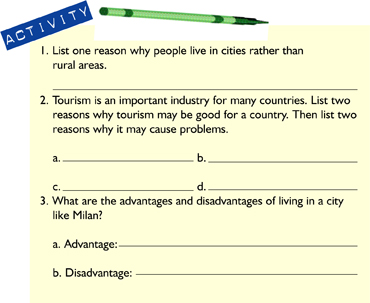
What Is the Culture of Italy?
Throughout this chapter, you have looked at what makes Italy Italian. You have read about its geography, climate, how the land is used, and Italy's history. You know about the differences between the North and the South. Another important part of life is culture. It's important to understand the religion, language, values, and everyday life that the Italian people share. Let's look at everyday life in Italy.
Look at the graph. Think about the conclusions you can draw from this information.
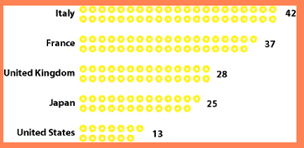 Average Number of Vacation Days a Year
Average Number of Vacation Days a Year
What Is School Like in Italy?
In central Italy, children go to school from the beginning of September to June. In the South, the summers are long and hot. Because of the heat, school does not start until the very end of September.
Children must go to school between the ages of 6-14. They attend la scuola elementare (primary school) until they are 11. From 12 to 14, is la scuola inferiore (junior secondary school). At 14, students decide what subjects they want to study at la scuola media superiore (senior secondary school). After 5 years, students take a national exam to get into college.
Remember Tomaso from Milan? He goes to school from 8:00 A.M. to about 1:00 P.M. But he also goes six days a week. Some parents have their children go from 8:00 A.M. to 4:30 P.M. Kids have a break and snack in the morning, but lunch is almost two hours long. And the lunches are big! Children start with soup, pasta, or gnocchi (potato dumpling). Then they have a hot main course. That might be fish, chicken, cheese, or eggs. Cooked vegetables and salad are also served. Finally, there is a dessert of fruit or yogurt.
What Is it Like to Live, Shop, and Eat in Italy?
Italians work an average of 36 hours a week. Many shops and offices close for a long lunch break. People take time off during the hottest part of the day. Offices and shops open again in late afternoon, but they often stay open until 7:30 at night.
Most people who live in cities live in apartments. Family is important to Italians. Many families have grandparents, aunts, or uncles living with them. In villages, the homes are close together and the streets are narrow. Every village has a town square, or piazza. People usually gather in the square to visit with one another. Families like to walk, called passegiata (pah
Additional topics
- Review
- How Has History Affected the People of Eastern Europe Russia? - Who Are the People of Eastern Europe?, What Is Eastern Europe Like Today?
- Other Free Encyclopedias
History Reference: Ancient History & World HistoryThe Eastern Hemisphere - Europe and Russia










